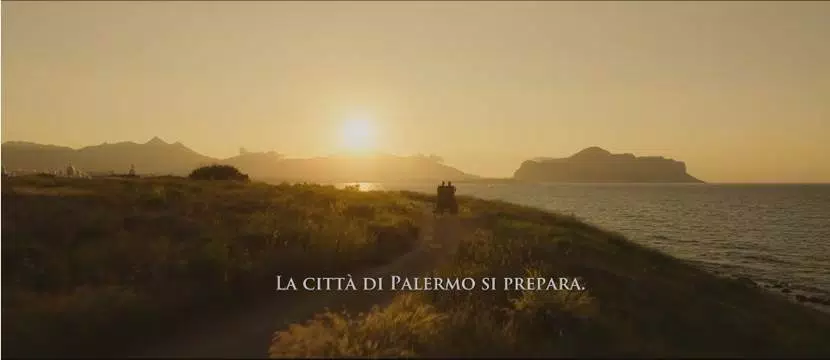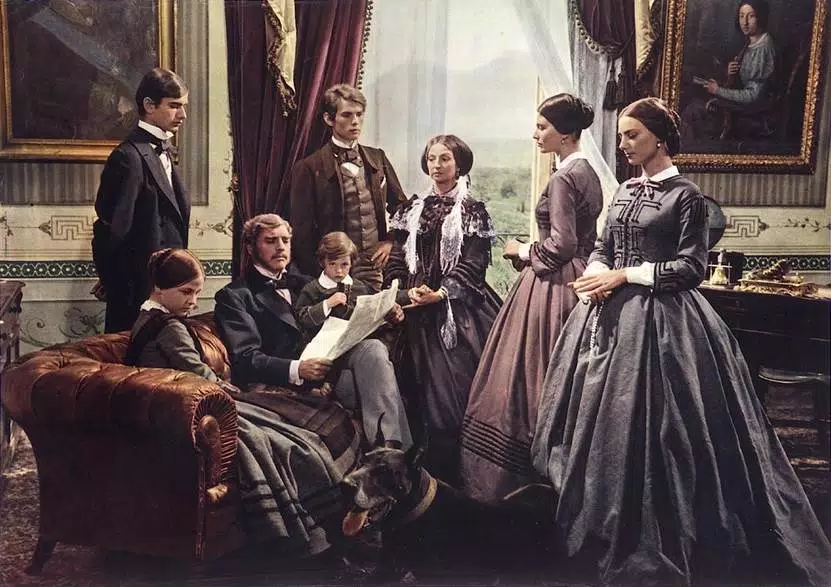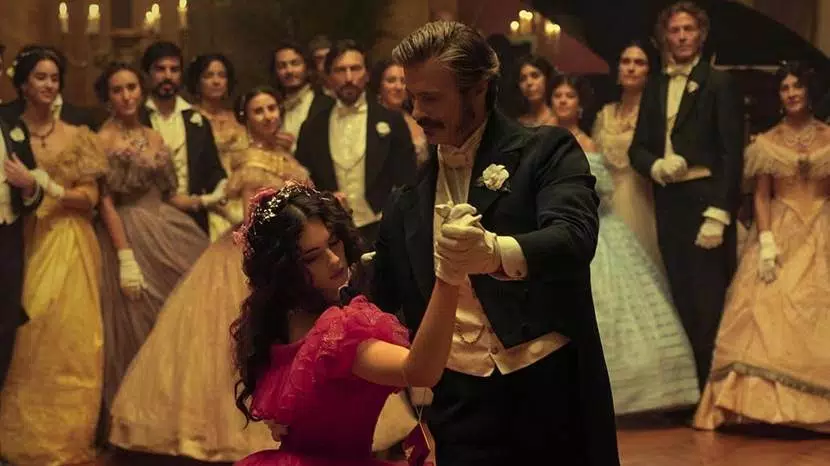Italy’s best-selling historical novel, “The Leopard,” now has a Netflix-produced series which takes a vastly different approach from Luchino Visconti’s 1963 Palme d’Or-winning film adaptation. However, maintaining an independent identity does not necessarily equate to outstanding quality. Compared to the classic film, Netflix’s “The Leopard” feels more like a hastily drawn historical picture book.
From the very first episode, watching the show is akin to flipping through a children’s illustrated book. The opening panoramic shot features a horse-drawn carriage racing along a coastal cliffside road bathed in the glow of the setting sun. Expository text, much like the text in a picture book, outlines the story’s background set in April 1860: The Italian peninsula is fragmented into numerous small kingdoms. Sicily has been under Bourbon rule for over a century, while in the north, a movement for Italian unification is rising. General Giuseppe Garibaldi has gathered an army, preparing to sail south. The city of Palermo is bracing for battle.

Now, compare this to the opening of Visconti’s film. In the chapel of the Salina family, Prince Don Fabrizio Corbera, nicknamed The Leopard, leads his entire household in prayer. The quiet is interrupted by noises from outside, and family members exchange glances, expressing curiosity and unease. Some appear vexed, others absent-minded, while a few remain composed. As a master director adept in both neorealism and historical war epics, Visconti swiftly established a tone that is both authentic and tinged with mythical romanticism.
A more iconic moment in film history is the introduction of Alain Delon’s character, Tancredi Falconeri, who is the Prince’s nephew. The camera lingers on a close-up of a mirror reflecting the Prince shaving. Tancredi then steps into the frame. This moment cements the dual protagonist structure: the Prince, a dignified conservative—celebrated in both the novel and its film adaptation as the “last nobleman”—and Tancredi, a cynical progressive who seeks change despite his wealth and status. The future of Italy belongs to Tancredi and his fellow Redshirts.

In Visconti’s film, the Prince’s stance on Garibaldi’s Redshirts and Italian unification is deliberately ambiguous. He detests change yet ultimately submits to it. Often, his perspective is conveyed through other characters. For instance, a family friend with close ties to the Redshirts explains, “It may be difficult to comprehend, but no matter how turbulent the outside world becomes, what the nobility truly fears is anything that disrupts their summer retreat to Donnafugata.”
The Netflix series, on the other hand, chooses to spell out the historical context explicitly and presents its characters in an overly simplistic, archetypal manner. The Prince and his eldest daughter, Concetta, embody the most admirable type of nobility; Tancredi and his beautiful wife, Angelica, are shrewd individuals who adapt to the times; the Donnafugata mayor, who later joins the newly unified Italy’s national parliament, is clearly portrayed as an opportunistic upstart. In the first episode, after the Redshirts easily capture Palermo, the Prince is fully aware of the impending historical upheaval but stubbornly refuses to acknowledge it. Instead, he says dismissively, “We’re in Sicily. It’s April now. In two months, it’d be so hot that these rioters will give up on the revolution and retreat under the shades of their homes until October.”

The series adopts this straightforward, picture-book-style exposition likely because modern streaming audiences lack the historical background knowledge that was more familiar to cinema-goers of the past century. As a result, the show feels compelled to present clear moral judgments. However, the performances of the two male leads fall short when compared to the film adaptation. If comparing any modern young actor playing Tancredi to the strikingly handsome Delon seems unfair, the series’ portrayal of Prince Fabrizio is even more surprising. After all, he is played by Italian star Kim Rossi Stuart, an actor adored by female audiences worldwide. Unfortunately, perhaps due to the script reducing the Prince to a simplified, one-dimensional figure, Rossi Stuart’s performance fails to match that of Burt Lancaster in the film.
The 1963 film notably dubbed its two leads, an American and a French star, in Italian. A close female friend of mine, a devoted fan of Rossi Stuart—for whom I once secured an autographed photo for when I interviewed him in Venice—admitted she was somewhat disappointed by his performance in the Netflix series.
Of course, I have never read Giuseppe Tomasi di Lampedusa’s grand historical novel and cannot determine whether the film or the series remains more faithful to the original work. However, for an adaptation, fidelity to the source material is not necessarily the ultimate measure of quality. Moreover, “The Leopard” is itself a largely fictionalized novel, inspired by the experiences of the author’s great-grandfather and enriched with historical details of the era. While also from an aristocratic family, Tomasi’s ancestor was far less wealthy, landed, or influential than the fictional Prince Fabrizio.

While watching the series, I happened to have a history book on my desk: “Sicily: A Short History from the Ancient Greeks to Cosa Nostra.” Naturally, I flipped to the chapter on the Italian unification movement. Interestingly, it made no mention of any prince who could stand on equal footing with the king, the Pope, or the revolutionary Garibaldi.
The book notes that after the Redshirts occupied Sicily, neither Garibaldi and his followers nor the enlightened aristocracy could understand why their vision of unification had turned into a class struggle. In the book, a friar remarked that for those without bread, freedom is not enough. Whatever that was happening in Sicily was a war of the oppressed against their oppressors, and the oppressors were not only in palaces but in every town. The situation demanded more than just the fall of the Bourbon dynasty, as some large estates had already been forcibly seized by peasants.

Although the series does not delve into the turbulent state of Italy around 1861 before and after unification—omitting the intricate conflicts involving the church and monarchy, the Second French Empire, the Austro-Hungarian Empire, the Bourbon-controlled Kingdom of Naples and Garibaldi’s Redshirts—it at least portrays the theme of “the oppressed resisting their oppressors” through the cunning and treacherous character of the Donnafugata mayor.
The book also describes the plebiscite held on October 21, 1860, in the Kingdom of Naples, Sicily, Umbria, and Marche, where citizens voted on whether these territories should join a unified Italy under King Victor Emmanuel II. The results were overwhelmingly in favor: 432,053 to 667. In reality, having never received any democratic education, many voters did not fully understand what they were voting for, and some even saw the voting as a tribute to Garibaldi.
The end of the Netflix series’ third episode features a scene depicting an electoral fraud in this historical referendum. A villager who had voted against unification sees his ballot changed to a vote in favor. Outraged, he confronts the corrupt Donnafugata mayor: “Mayor! You’ve told a preposterous lie! How is it possible that there’s no opposition vote? What about mine, Don Calogero? You were going to win anyway. Why did you have to lie? If this is the new Italy, it’s like a deformed calf that’s innately corrupt and sacrilegious! Just like you, Calogero Sedara!”
Progress and equality are undoubtedly positive ideals, but more than a century and a half later, we look at modern Italy that still echoes the complaints of this minor character. As “The Leopard” depicts, the affluent and sophisticated north and the chaotic, lawless south remain worlds apart. Yet, like the Prince in the novel, I still find myself drawn to the rugged charm of the southern way of life rich with human connection.







Share your thoughts!
Be the first to start the conversation.